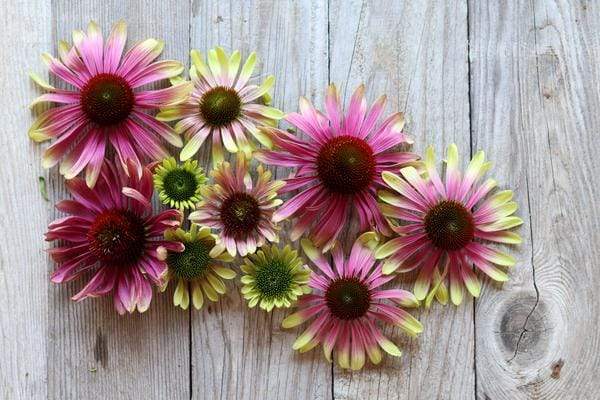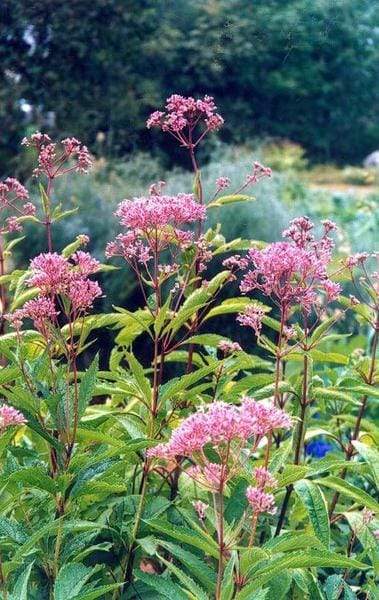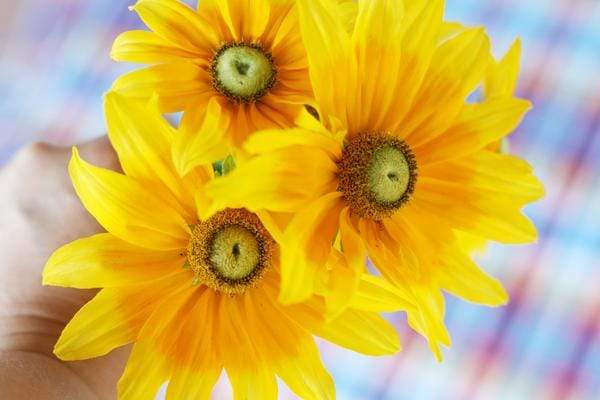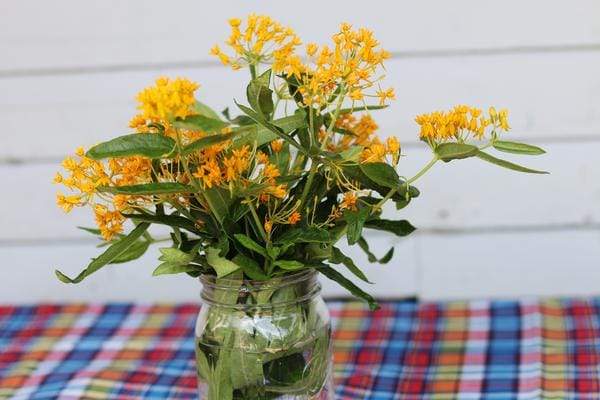Guest Blog Post
Hi everyone! This is Allison over @FinchAndFolly. I’ve been dreaming of my garden so much over these past few months that I can’t believe that it’s actually time to get sowing! Over the past decade, I’ve made a concentrated effort to introduce more flowers into my garden. At first, I was reluctant to share my valuable growing space with something we couldn’t eat, but the transformation that the flowers brought was undeniable. The more flowers we had, the more pollinators we attracted, which led to the production of more produce. This summer, I’m taking my largest leap yet and moving our vegetables to a new garden plot out back and turning over our existing garden to perennials, annuals, and herbs. My ultimate vision with this new plan is to create a pollinator’s paradise that’s buzzing with activity from spring through frost.
Let’s bee serious for a minute…our pollinator pals need our help, and frankly, we desperately need theirs. Our bee population alone has been in rapid decline over the past 25 years due to a variety of causes, including pesticides, parasites, and an overall lack of crop diversity. This is especially eye-opening when you consider that bees pollinate one-third of the food we eat. But the good news is, we can help! And it can start as simply by planting one pot of perennials.
Garden pollinators come in all shapes and sizes. They’re bees, wasps, moths, butterflies, birds, beetles, and even mosquitos. All are vital for having a healthy, vibrant ecosystem. You can attract certain pollinators just by the color of flowers your plant. Bees love hues of blues, purples, yellows, and whites, while butterflies flock to reds, purples, and yellows.
Even the shape of your flower can be key to attracting pollinators as well. While those double and ruffle blooms are beautiful, pollinators actually prefer single-flowered varieties. Not only do the single flowers make it easier for the pollinators to collect the pollen and nectar, they actually produce a higher amount of both when compared to their double-blooming varieties. Tubular flowers like Honeysuckle, Lupine, and Anise Hyssop attract pollinators with longer proboscis reach, like hummingbirds and moths.
When plotting out your perennials, seek out to incorporate at least one-third native plants. Not only are they adapted to grow in your climate, they also attract more pollinators. If you’re curious as to what the native plants are in your area, visit your local university’s cooperative extension website for a great resource to growing local.
The other thing to take into consideration is to plan for a sequence of blooms so that pollinators can have a source of nectar throughout the season. Early and late blooming perennials are important for our pollinator pals as these are the times of the season when their food sources are more scarce. In the spring, pollinators awake from dormancy and they need to refill their depleted energy reserves with nectar and pollen. Come fall, these same pollinators are looking to fill up with a few feasts before winter arrives.
And finally, plant your perennials in groupings of 5-7 of the same variety. This allows the pollinators to more easily collect pollen and nectar from a single species, something they’d prefer. Plus, grouping your flowers in mass creates striking visual displays.
Here are a few of my favorite pollinator-loving perennials:
Echinacea (also known as Coneflower)
- Likes full sun to light shade with well-drained soil.
- Zones 3-10
- 3’-4’ tall
- Sow 8-10 weeks before last frost date.
- Blooms summer through fall.
- Attracts small native bees. Bees and butterflies love it.
- Makes a stunning visual impact when planned in mass. Also beautiful when paired with Rudbeckias, and Monarda.
- Don’t cut back in fall, as birds will feast on the seed heads.
- Deer-resistant. Drought tolerant.
- Fairly low-maintenance flower to grow.
- Likes full to part sun in well-drained soil.
- Zones 4-9
- Grows in upright clumps, 2’-4’ tall
- Sow 4-6 weeks before last frost date.
- Easy to start from seed and blooms in its first year. Seeds need light to germinate. Cold-treating seeds in the refrigerator a week prior to sowing aids in germination.
- Blooms purple tubular flower spikes summer through fall.
- Provides nectar-rich blossoms which attract honeybees, bumblebees, butterflies, moths, and hummingbirds.
- Edible flowers that taste like anise. Leaves can be used in herbal teas, jellies, and potpourris.
- Works well in middle and back borders. It’s especially lovely when paired with Rudbeckias, Monarda, and Purple Coneflower (Echinecea).
- Deadhead to encourage additional blooms.
- Deer-resistant. Drought-tolerant.
- Active self-sower.
- Don’t cut back in fall, as birds will feast on the seed heads.
Eupatorium (also called Joe Pye Weed)
- Likes sun to part shade in rich, well-drained, moist soil.
- Zones 4-8
- 4’-6’ tall and 2’-4’ wide
- Sow 8-10 weeks before last frost date.
- Keep new plants well-watered until they become established.
- Fragrant flowers blooms late summer.
- If sown early, will bloom the first year.
- Attracts butterflies, moths, hummingbirds, and birds.
- Great for back of the border plantings.
- Wonderful native plant to much of the U.S.

Monarda (also called Bee Balm or Bergamot)
- Likes full to part sun in well-drained, moist soil.
- Zones 4-8
- 2’-3’ tall
- Sow 6-8 weeks before last frost.
- Blooms mid-summer through early fall.
- Attracts bumblebees, hawk moths, and hummingbirds.
- Edible leaves make a lovely tea.
- Make sure it gets plenty of air flow as Monarda can fall to powdery mildew.
- Captivating when planted in mass.
Rudbeckia (also called Black-eyed Susans)
- Likes full sun to light shade in well-drained, moist soil.
- Zones 3-9
- 2’-3’ tall
- Sow 8-10 weeks before last frost date.
- Blooms midsummer through fall.
- Attracts butterflies and birds.
- Creates a dazzling display when planted in large groupings.
- Drought-tolerant.
- Fairly low-maintenance flower to grow. They naturalize after a few years.
Yarrow (Achillea)
- Likes full sun in well-drained soil. If soil is too rich, flowers will be floppy.
- Zones 3-9
- 2’-4’ tall
- Sow 8-12 weeks before last frost date.
- Blooms late spring through late summer.
- A favorite of native bees and also attracts butterflies.
- Fairly low-maintenance flower to grow. Deadhead to encourage new blooms.
- Deer-resistant. Drought-tolerant.
- Beautiful dried flower.
- Active self-sower.
Milkweed (Asclepias)
- Likes full sun in dry, well-drained soil. It actually thrives in poor soil.
- Zones 3-9
- 3’-4’ tall
- Sow 10-12 weeks before last frost date.
- Blooms in summer.
- Attracts bees, butterflies, and hummingbirds. Serves as host plant for Monarch butterfly eggs.
- Deer-resistant. Drought-tolerant.
- Collect seed pods in fall and use in dried arrangements.
- Can self-seed.
- Low-maintenance flower to grow.
Now bring on the bees and butterflies to your garden!
SOURCES:
Penn State Extension “Best Plants for Pollinators”
University of Vermont “Ten Top Perennials to Please Pollinators”
University of New Hampshire “Pollinator Plants for Northern New England Gardeners”
The Honey Bee conservancy.org “Plant a Bee Garden”
Lolo National Forest “Attracting Pollinators to Your Garden”
Mother Earth Living website
“Perennials for Today’s Garden” by Better Homes & Gardens
“Perennial Gardens” by Better Homes & Gardens
“Flower Gardening Secrets” by Cynthia Van Hazinga








My favorite is the Rocky Mountain Bee Plant! They are always full of bees and wasps.